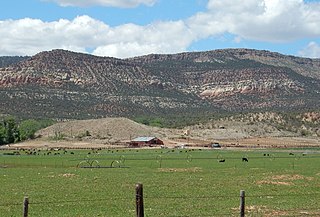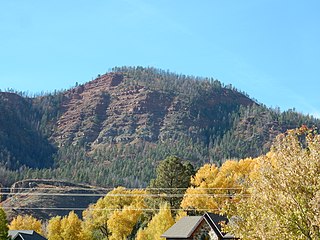
The exposed geology of the Canyonlands area is complex and diverse; 12 formations are exposed in Canyonlands National Park that range in age from Pennsylvanian to Cretaceous. The oldest and perhaps most interesting was created from evaporites deposited from evaporating seawater. Various fossil-rich limestones, sandstones, and shales were deposited by advancing and retreating warm shallow seas through much of the remaining Paleozoic.
The Honaker Trail is a hiking trail located near Goosenecks State Park in southeastern Utah. Built in the late 1890s and early 1900s as a supply route for gold prospectors, the 2.5-mile (4.0 km) trail connects the deeply entrenched San Juan River with the canyon rim over 1,200 feet (370 m) above. Popular with geologists, the trail serves as the type locality for the Pennsylvanian Honaker Trail Formation. Fossilized crinoids and brachiopods, as well as trace fossils of other organisms are visible along portions of the trail.

In geology, the Paradox Formation Is a Pennsylvanian age formation which consists of abundant evaporites with lesser interbedded shale, sandstone, and limestone. The evaporites are largely composed of gypsum, anhydrite, and halite. The formation is found mostly in the subsurface, but there are scattered exposures in anticlines in eastern Utah and western Colorado. These surface exposures occur in the Black Mesa, San Juan and Paradox Basins and the formation is found in the subsurface in southwestern Colorado, southeastern Utah, northeastern Arizona and northeastern New Mexico.

The Pennsylvanian to Lower Permian,, Supai Group, is a slope-forming section of red bed deposits found at the southwest-to-south Colorado Plateau. Cliff-forming interbeds (sandstone) are noticeable throughout the group, as well as the largest cliff-former the topmost member Esplanade Sandstone. The Supai Group is especially exposed throughout the Grand Canyon in northwest Arizona, as well as local regions of southwest Utah. It outcrops southeastwards in Arizona at Chino Point, Sycamore Canyon, and famously at Sedona as parts of Oak Creek Canyon. In the Sedona region, it is overlain by the Hermit Formation, and the colorful Schnebly Hill Formation.

The Gros Ventre Formation is a geologic formation in Wyoming, USA. It preserves fossils dating back to the Cambrian period. The Gros Ventre consists of three main members; the Wolsey Shale, the Death Canyon Limestone, and the Park Shale.
The Trail Canyon Formation is a geologic formation in Idaho. It preserves fossils dating back to the Permian period.
The Nopah Formation is a geologic formation in Utah. It preserves fossils dating back to the Cambrian period.

The Notch Peak Formation is a geologic formation in Utah. It preserves fossils dating back to the Cambrian period.
The Dunderberg Shale is a geologic formation in Nevada and Utah.
The Deseret Limestone, also known as the Pine Canyon Formation, is a geologic formation in Utah. It preserves marine fossils dating back to the Carboniferous period or Mississippian age. It was formed by the Panthalassa ocean around 340 Ma. Fossils are mostly of tabulate and rugose corals, and other marine invertebrates; vertebrates are represented by conodonts. The Deseret is a 500-foot thick layer of dolomitic limestone with chert, with a basal layer of black shale that is host rock for many Utah caves such as Timpanogos Cave National Monument.

The Hermosa Group is a group of geologic formations in Utah and Colorado. It preserves fossils dating back to the Carboniferous period.
The Manning Canyon Shale is a geologic formation in Utah. It preserves fossils dating back to the Carboniferous period.

The Burro Canyon Formation is an Early Cretaceous Period sedimentary geologic formation, found in western Colorado, the Chama Basin and eastern San Juan Basin of northern New Mexico, and in eastern Utah, US.

The Ferron Sandstone Member of the Mancos Shale is a geologic unit in Utah. It preserves fossils dating back to the Cretaceous period; and more specifically the middle Turonian.

The Price River Formation is a geologic formation in Utah. It preserves fossils dating back to the Cretaceous period. The Price River Formation is approximately 200 metres (660 ft) thick at its type locality and consists of cliff-forming sandstone and siltstone visible in the Book Cliffs.
The Fillmore Limestone is a geologic formation in Utah. It preserves fossils dating back to the Ordovician period.
The Arcturus Formation is a geologic formation in Nevada and Utah, United States. It preserves fossils dating back to the Permian period.
The Elephant Canyon Formation is the basal Permian geologic formation of the Cutler Group overlying an unconformity on the Pennsylvanian Honaker Trail Formation in the Paradox Basin of southern Utah.
The Wood Canyon Formation is a geologic formation in the northern Mojave Desert of Inyo County, California and Nye County and Clark County, Nevada.

The Kanosh Formation is a geologic formation in Utah and Nevada. It preserves fossils dating back to the Middle Ordovician period.












